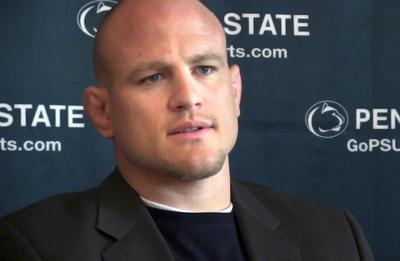I met Cael Sanderson at a wrestling clinic at Millersville University in 2002.
Unlike many clinicians, he wasn’t interested in talking. He spent most of his time on the mat, allowing himself to be pummeled by the kids.
“They trip me when I’m not looking,’’ he said later. “They slap me upside the head.’’
After a bit of that he’d rise to his feet, one unlucky grappler wrapped in a single-leg, bouncing helplessly on the other foot.
Sanderson would wordlessly wrap the kid up like a pretzel and move on.
This was a few months after Sanderson finished his college career at Iowa State. With a Wheaties Box and an ESPY and a bobblehead doll, he was already a celebrity, if a reluctant one.
“I’m glad the Iowa State people made a bobblehead for me,’’ he said. “But they were setting me up where if I went out and got pinned every match, people would have wanted their money back.’’
Yesh, like there was a chance of that happening. Sanderson went 159-0 in college, with four NCAA titles and four NCAA Tournament Most Outstanding Wrestler awards. This was after winning four state titles in in high school, and that was after winning a state junior high championship, in Utah, when he was in fourth grade.
Ambassadorship of wrestling was what was expected of him at the time. Asked about it that day, he launched into a predictable answer and then trailed off.
“Aw, I’m just making stuff up now,’’ he said.
As insane as it seems, it was reasonable to ask, nearly a quarter century ago, what might be next for him. Sure, a couple Olympiads and a world freestyle championship or two, but that wouldn’t even get him through his 20s.
What after that?
I recall thinking, with the prescience that has served me so well over the years: I don’t see coaching for this guy.
Sanderson is now the most successful coach in American sports. That’s almost underbilling.
Sanderson took over at Penn State in 2010. The Lions have since gone 213-16-2 with 11 NCAA titles of a possible 13. They have won 66 straight dual meets. With the exception of the COVID-truncated 2020 season, they haven’t lost a dual meet since 2015.
They’ve won three straight NCAAs and, last year, set an NCAA championship meet record by scoring 172.5 points.
This all comes up because the sport’s most-hyped event in years came and went Friday, when second-ranked Iowa came to Happy Valley.
There were 16,000 in the stands, nationally-ranked All-Americans in nearly every match, concert-level light shows and effects in the building and even pro-wrestling-style trash talk.
"We've got Penn State next week and we didn’t get the job done last year and that kind of sucks,’’ Gabe Arnold, Iowa’s undefeated 184-pounder, said last week in a tirade aimed at Penn State’s Carter Starocci, a four-time NCAA champ.
“But we’re gonna get it done this year. So this time we'll be in your home dojo, and I promise, your head's mine."
Except that Arnold didn’t wrestle Friday. Starocci beat Iowa freshman Angelo Ferrari routinely.
“We had a thought process in place, said Iowa coach Tom Brands. “The rule is that we get five dates (before redshirting Ferrari). We’re going to use them… And we’re not going to use them against Cupcakes.
“We have to load manage Gabe Arnold - that’s the term in the NBA that people don’t like. Gabe Arnold, we need to make sure that he’s still going good down the stretch. He’s going to be our guy at (184).”
Wow.
Penn State won 30-8. It had all the drama of a municipal board meeting, except for a dramatic, and symbolic, high point.
At 157, Penn State’s Tyler Kasak had a 5-2 lead over Jacori Teemer with time running out. Kasak lifted Teemer off the ground, and held him in one arm, as time ran out, while lifting the other arm in triumph.
Teemer had been undefeated, and ranked first in the country.
The crowd went nuts.
“I kind of blacked out,” said Kasak, who had cut his head open during the match and finished wearing a bandage. “I have no idea what I really did.’’
Number one versus number two? This looked more like varsity vs. JVs.
And it turns out Sanderson is a better talker than I remembered.
"There’s a higher standard than winning and losing,’’ he said. “It was never about winning and losing. It was about fighting. You don’t have to tell somebody you want to win.’’
Once in a very great while - think Tiger Woods in 2000 - an athlete or team gets so far ahead of everybody else that it doesn’t make sense.
Penn State wrestling is so good doesn’t make sense.

